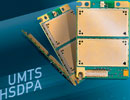

The HC15 wireless module from Siemens Automation and Drives (A&D) combines HSDPA (high speed downlink packet access) technology with a robust interface and mounting concept, and is controlled via AT commands.
This allows particularly fast and efficient development of high-speed data applications such as gateways, USB modems or routers. This new module belongs to the Siemens product portfolio of wireless modules, which was assigned to the A&D Group on 1 October 2006.
The HC15 offers a download data rate of 3,6 Mbps. It operates on the 2100 MHz frequency band and is therefore suitable for applications in Africa, Asia, Europe and the Middle East. To facilitate the development of Windows-based applications, the module offers an NDIS (network device interface specification) driver and USB 2.0 Full Speed interface. In addition, Siemens supports its customers during application development by providing comprehensive services from design-in to approval.
The HC15 wireless module already complies with approvals in accordance with R&TTE and GCF as well as regional network operator requirements in Africa, Asia, Europe and the Middle East. The module also complies with the EU regulation RoHS (Restriction of Specific Hazardous Substances in Electrical and Electronic Equipment).
About HSDPA
HSDPA is a packet-oriented data transfer standard based on the UMTS network with 10 times the download rate of UMTS. The network efficiency for the network operator is double that of a GSM-based network. In addition to faster data transfer, applications based on HSDPA technology also enable a latency time that is seven times shorter than that of a GPRS network. HSDPA is thus suitable for new telecommunications services such as live streaming of video and music, interactive games, high-speed data downloads and broadband Internet and e-mail access.
For mobile network operators, HSDPA is particularly interesting because of its network efficiency: HSDPA offers up to three times more capacity as UMTS. Thus, this provides the opportunity to replace the fixed line broadband Internet access with wireless technology. The predictions for HSDPA technology are more than promising: according to the Global Mobile Suppliers Association (GSA) today there is already a commitment for 132 HSDPA networks in 66 countries. The GSA predicts that the technology family, to which HSDPA belongs, will be the future data standard for mobile communication with a market share of 90%.
More information can be found at www.siemens.com/hsdpa-module

© Technews Publishing (Pty) Ltd | All Rights Reserved